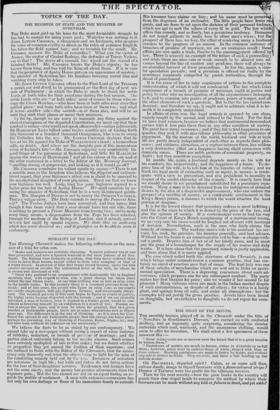THE HOAX OF THE MONTH.
THE monthly hoaxes, played off in the Chronicle under the title of i " Novelties n Gentlemen's Dresses," are carried on with unabated drollery, and an ingenuity quite surprising, considering the slender materials which coat, waistcoat, and the anonymous clothing, would seem to offer for invention. We shall select a few specimens of these innocent fibs :— "Some riding-coats are so narrow over the breast that it is a great trouble to button them."
"Pantaloons of nankin are much in favour, either in deshabille or in full dress; however, many wear in undress those of white, striped with blue or fhime colour. Morning pantaloons are made to fasten by hooks, and without any fold or fulness in front. They are wide, and have a full beading up the outside seams.'
Oh BRUMMELL, departed spirit ! Calais, or as some call thee, callous dandy, image to thyself trowsers with aflame-coloured stripe ! Flames of Tartarus were too gentle for the villanous wearers. Then for the next novelty—how the poor bucks in the country will puzzle their dear stupid heads to conceive the method by which their trowsers can be made without any fold or fulness in front, and yet wide! .01'he buttons of the shirt are of black jet, with a small dot of gold in the centre. [The beast!]
' The colerettes worn by some fashionables are double, one falling below the cravat, the other standing up ; that which falls is laid in small plaits ; the other part, which touches the chin, is disposed in flutings. "When gentlemen go on a fishing party, they wear a round sailor's jacket, 'without a waistcoat ; a straw-hat, very short-quartered shoes of ticking, and knit thread pantaloons.
"Some fashionables, instead of shirt-collars, wear a kind of colerette, like those worn by youths, which surrounds the cravat about an inch beyond it This fashion seems to prognosticate the revival of ruffs among the petits- +mitres of the nineteenth century, similar to those worn by the courtiers in the reigns of Henry VIII. and Queen Elizabeth."
Oh, man, omit not• to mention that some fashionables wear a conical cap on their heads, with a flourishing embellishment of bells at the apex thereof. Soing men of fashion, too, are seen in a blouse,—or, to speak Anglice, a smock frock of indigo blue, or suspected white, with beautiful needle- work about the breast, which has a very fine effect. They wear no coats underneath ; and are remarkable for constancy to their shirts, being persons in high office, and inimical to changes. They wear shoes which come liberally up the instep, and lace with delicate thongs of leather: they stuff hay or straw into the unoccupied places of these spacious apartments for the feet,—which has a pretty pastoral look.
Their stockings—for some men of rank still wear them—are of worsted, except where there are holes in them, or open work, when the gentleman's hide appears. They carry long whips in their hands— which method of conveying them is very odd and novel ; and they cry gee-whup, and sometimes gee-ho. Having suggested this amendment, we return to our text, which now begins to frighten us. Popery is creeping into our habits. Horse-hair shirts are coming into fashion, which will be broached to our precious bodies with tenpenny nails. Let Sir ROBERT HARRY INGLIS and Mr. SADLER (not the aeronaut, but the air-and-nought gentleman) look to it :— "We know not which to appreciate most in these days, the march of fashion, or the march of industry [the serpent !] ; but a new discovery will operate, there is little doubt, to bring about a complete revolution in our system of clothing. This discovery, which is destined to replace the tissues forrned.of linen and cotton, which have hitherto been made use of for summer waistcoats and pantaloons, gaiters and hunting-coats, consists in a material called crenoiine, which, as its name indicates, is composed of crin or horse-hair. This manufacture is truly admirable."
Gentlemen who wear this piquant article, will add to it a sackcloth frock, and powder their heads handsomely with coal-ashes. Having then seated.themselves on a barrow turned spikes upwards, or a bench in the Haymarket Theatre, they will be comfortable in their minds. More novelties:— " A new game has been played lately, named Billiard-Champitre. This is played very easily on a bowling-green, or grass-plot. There are two tables, one breast-high, on which are two, three, or four brackets ; the other table, situated at some distance from the first, is pierced with as many round holes as there are brackets. This is five or six feet high, and on a vertical plan; the other on a reclining plan. They place a wooden billiard-ball on the bracket. With one stroke of the queue they cause the billiard-ball to enter the hole op- posite to that bracket. A cloth, spread out behind the vertical board, pre- vents the billiard-balls from striking against the pedestrians, or from being lost in the garden. The first billiard-balls often are struck to the right, to the left, above or below the hole ; but when once the hand gets accustomed to it, or, as the players term it, steady, they, without taking much aim, suc- ceed, almost at every stroke of the queue, in putting a billiard-ball in this new kind of vertical pocket."
What an ingenious and pretty sport We only find fault with the apparatus for stopping the balls ; which could not be better employed, under Heaven, than in bowling down the company, banging their shins, and making cannons off their egregiously stupid heads.



















 Previous page
Previous page